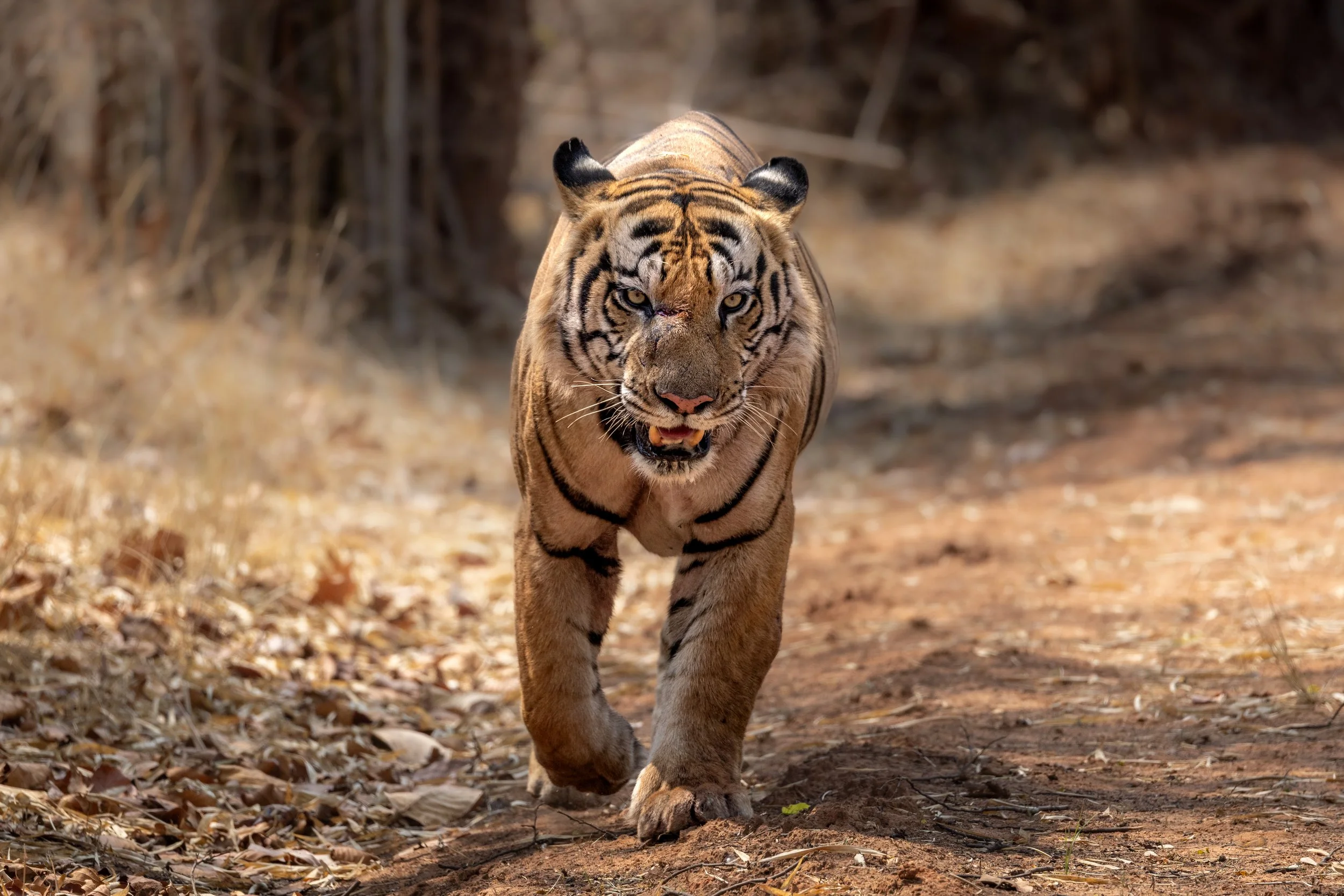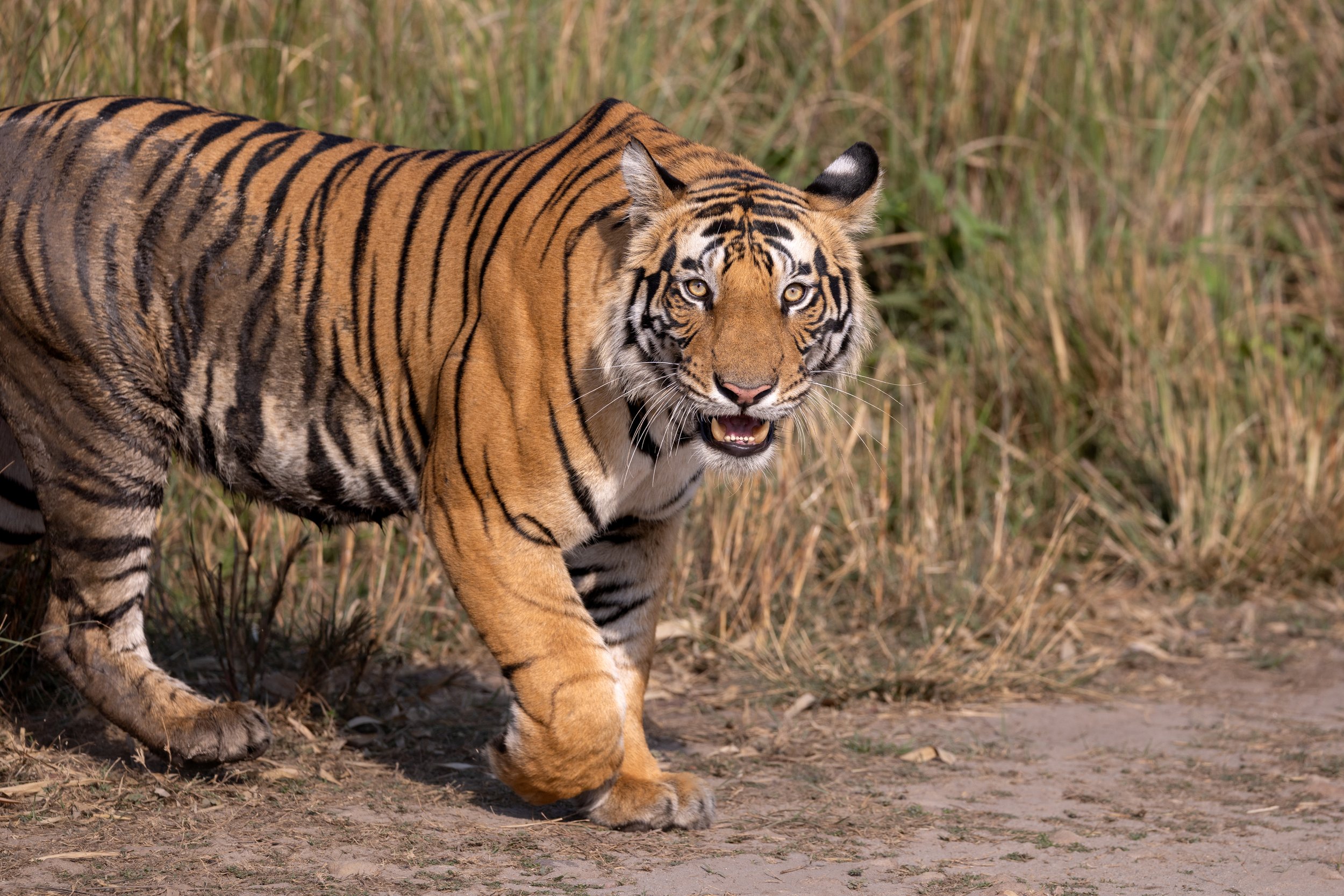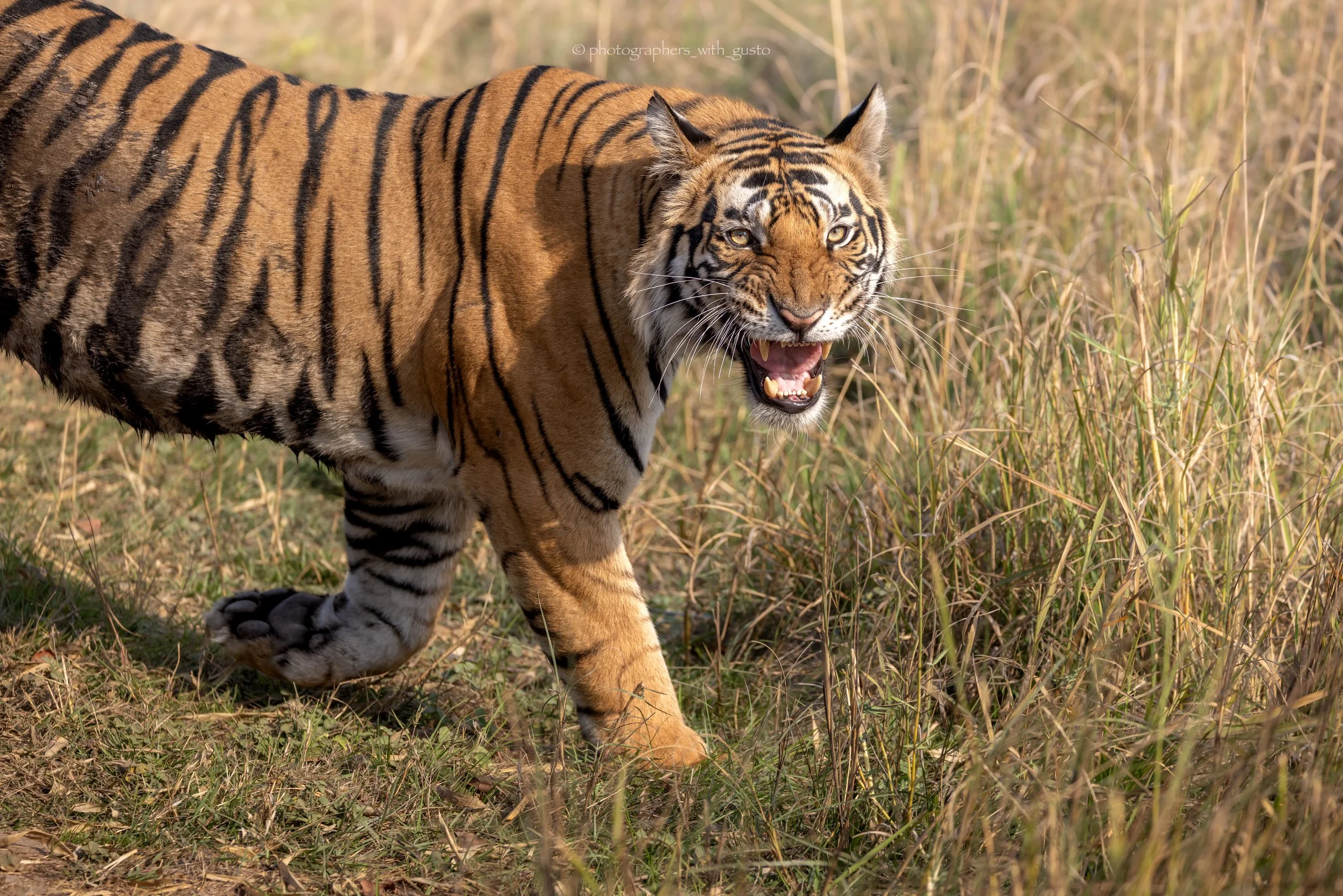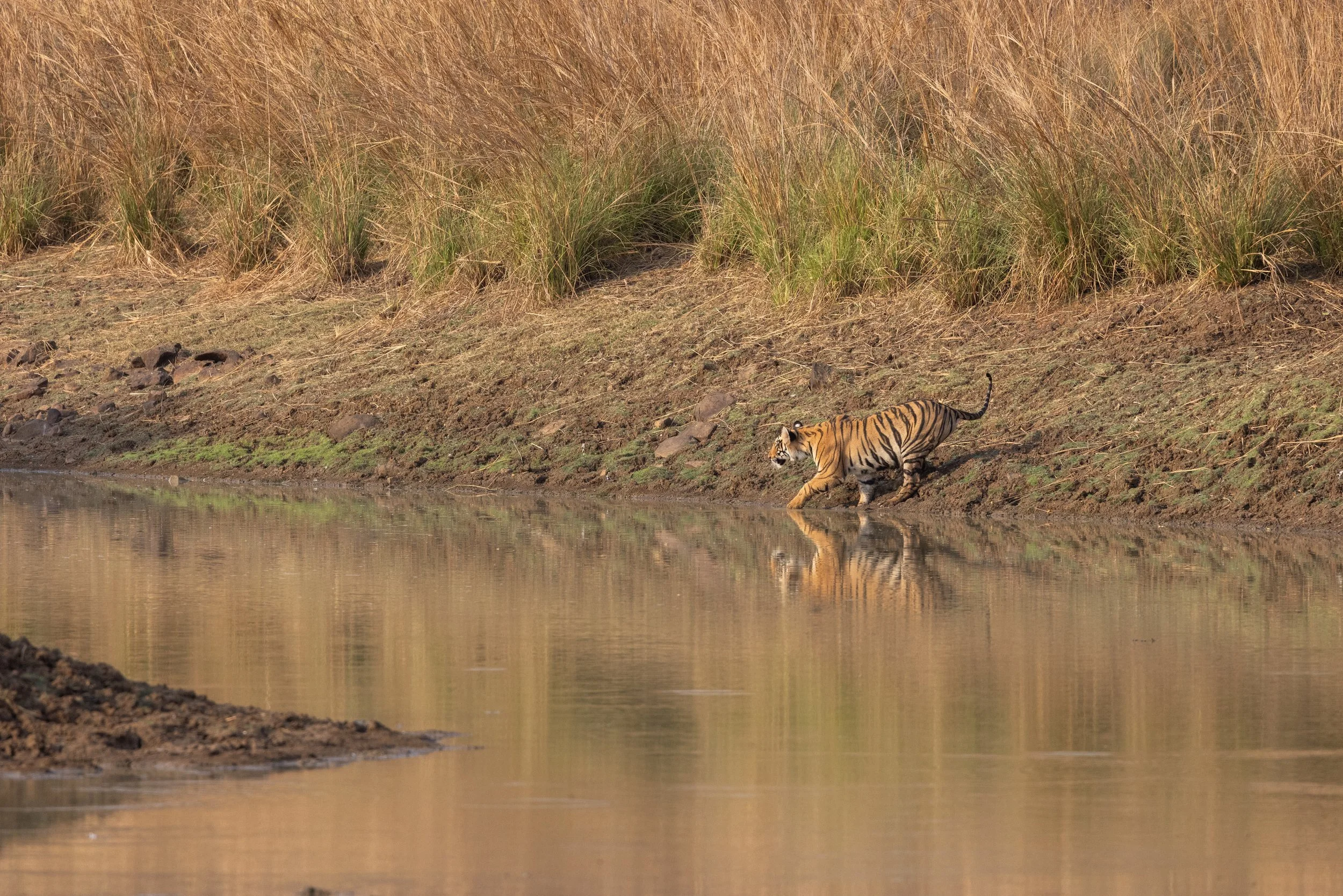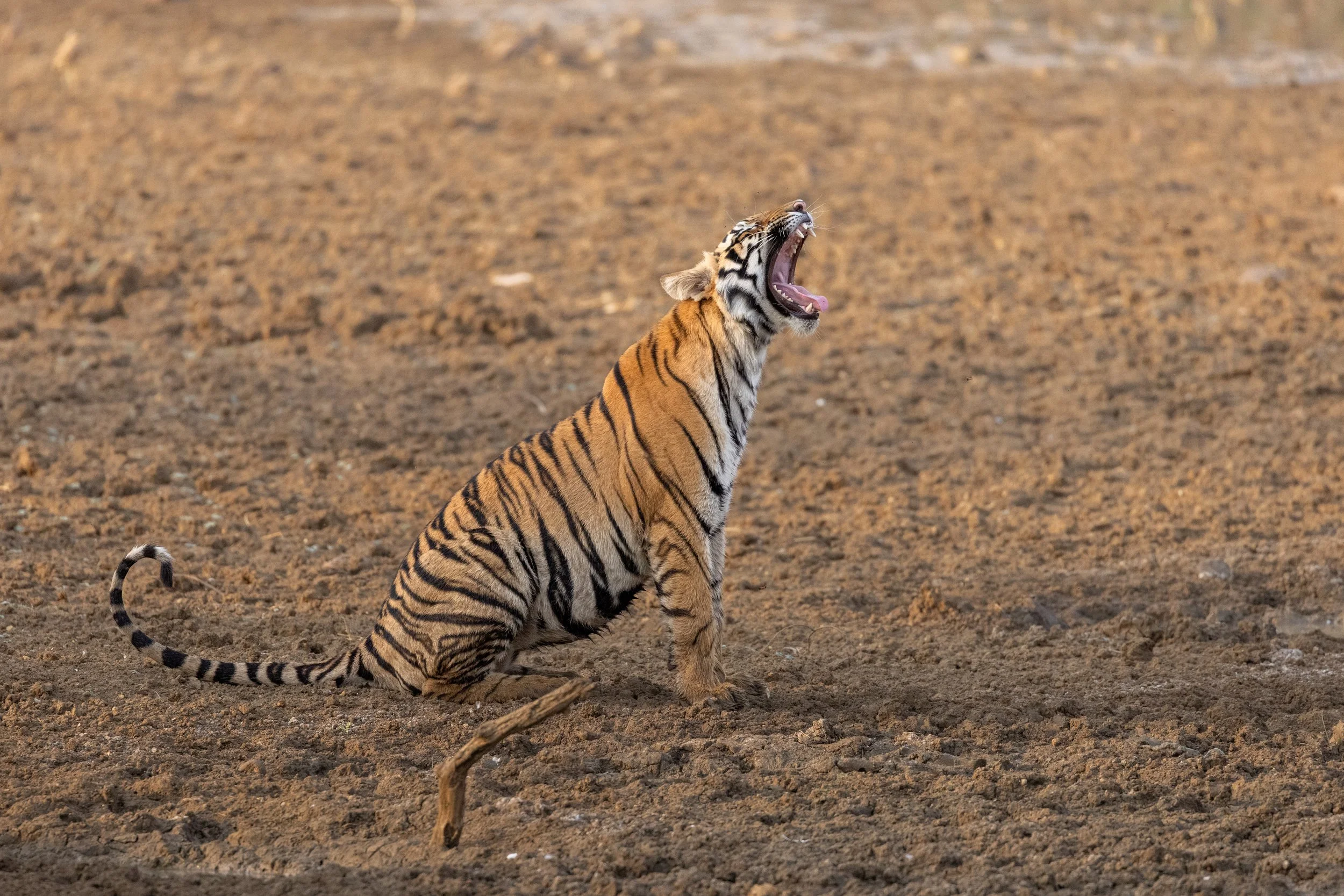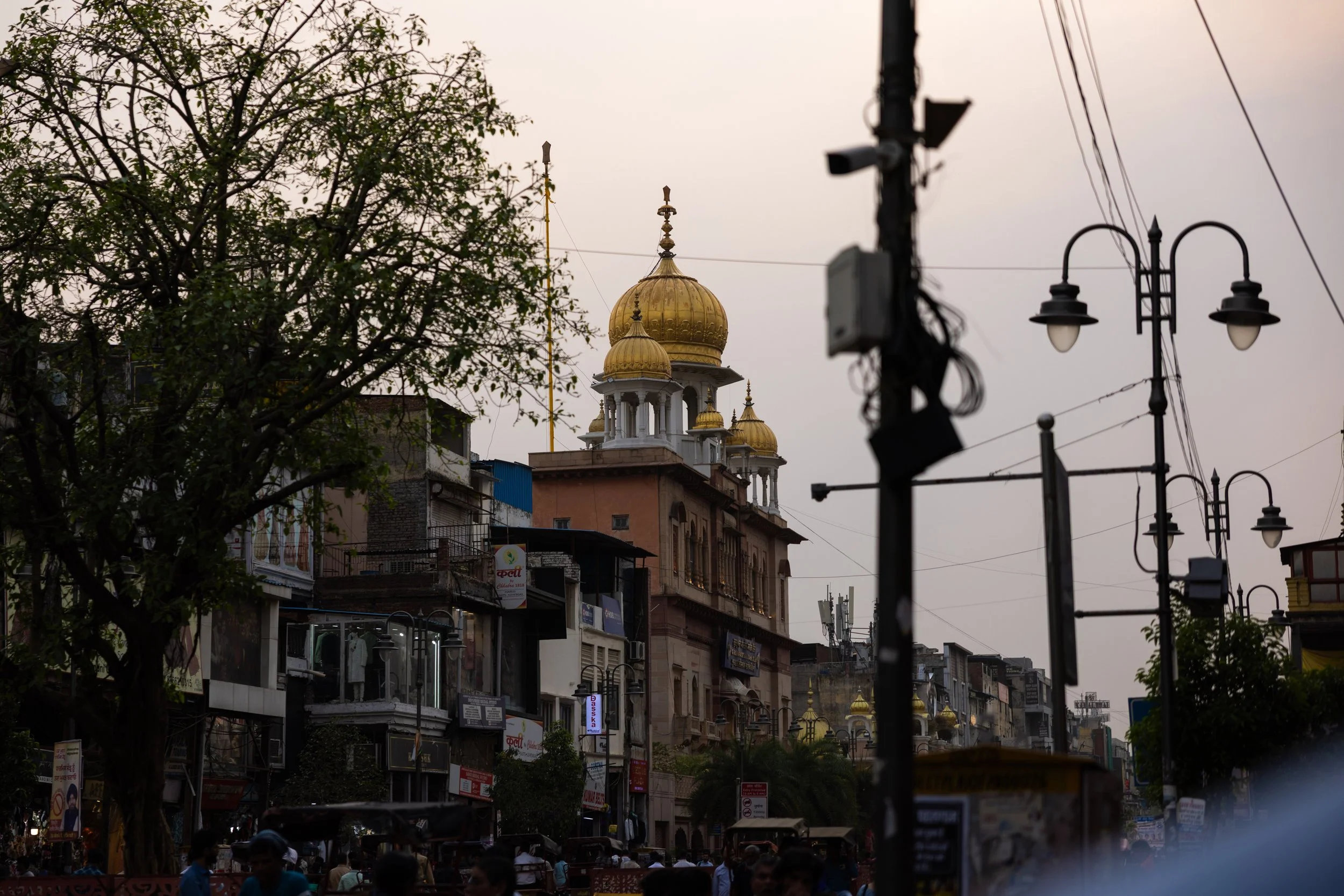India
On April 15, 2025, our journey to India began under the theme “following the tigers tracks”.
The Bengal tiger is the most well-known tiger species in India and is considered the national animal. It lives in various regions of the country, including the national parks we visited. India is home to the world’s largest population of this tiger species. Bengal tigers prefer forests, grasslands and mangrove swamps as a habitat. They are solitary animals and usually hunt at night. Their prey includes deer, wild boars and also smaller animals.
After two long days of travel including a stopover and overnight stay in Delhi and a flight to Jabalpur we arrived in the Bandhavgarh National Park area after a four-hour drive. Bandhavgarh National Park is located in the state of Madhya Pradesh in central India and is one of the country’s most famous national parks. It was established in 1968 and today covers an area of approximately 1,536 km² (including buffer zones). The park is especially renowned for its high density of tigers – offering good chances to observe Bengal tigers in the wild. In addition to tigers the park is also home to leopards, wild dogs, deer, jackals and over 250 bird species. The landscape varies featuring dense sal forests, grasslands, hills and historic ruins. A striking feature is the ancient Bandhavgarh fort which gives the park its name and boasts a history spanning over 2,000 years. The best time for a visit is from October to June with the summer months (March to May) offering the best chances of spotting tigers.
On our first morning drive in Bandhavgarh National Park Zone 2 we were already lucky to see our first male tiger named Bajreng. We followed him to a waterhole where he cooled off after making a kill earlier in the morning. During the evening drive through Zone 2 we saw the same dominant male tiger again - this time resting in the undergrowth occasionally rolling over from side to side.
On the following morning drive we were again very fortunate: in Zone 1 we encountered another male tiger named Jamhole and shortly thereafter his son who was strolling through the grass in the glow of the morning sun. His son had not yet been given a name as tigers are usually named at around two to three years of age based on their habits or territory. That evening we were again assigned to Zone 2 where we saw Bajreng once more making his way to the waterhole after a nap in the afternoon heat to cool down. As a farewell he returned to his kill.
In addition we were treated to more fantastic sightings of India’s wildlife. The landscape, flora and fauna truly impressed and inspired us.
On the morning of the following day after breakfast we embarked on the long journey to our next destination – Kanha National Park.
Kanha National Park is located in the state of Madhya Pradesh in central India and is one of the largest and most renowned national parks in the country. It was established in 1955 and covers a core area of about 940 km², with additional buffer zones bringing the total area to over 2,000 km². Kanha is known for its impressive wildlife and is home to the Bengal tiger, leopards, barasinghas (swamp deer – the park’s emblem), gaurs, wild dogs and numerous bird species. The landscape is diverse with dense sal and bamboo forests open meadows, rivers and gentle hills. The park is a pioneer in wildlife conservation and played a crucial role in saving the barasingha from extinction.
Upon arrival, we went on an evening game drive through the stunning scenery of the Kanha Range Zone. Surrounded by vibrant wildlife, we could hardly believe our luck when a sloth bear crossed our path. Another highlight came shortly after when we spotted a male tiger named Ver Singh in the dense bamboo forest before exiting the park that evening.
The following morning — Easter Sunday in Germany — held a unique Easter surprise for us in the Mukki Range Zone: we witnessed a tigress hunting a spotted deer and were able to follow the kill. After a period of waiting and enjoying many bird sightings DJ9 (the tigress) passed us again on her way to a lake to drink. The morning drive was a complete success.
During the evening drive we saw many other fascinating animals including various bird species, sambar deer, spotted deer, swamp deer, barking deer, wild boars, jackals and gaurs. We drove once more through the beautiful landscape of the Kanha Range Zone bathed in the golden light of the afternoon sun followed by a breathtaking sunset.
On the next morning drive in Kanha National Park we again set out in search of tigers and other wildlife in the Mukki Range Zone. We sighted a sleeping male tiger named DB3 — the father of the tigress DJ9 — as well as a sleeping tigress named DJ — the mother of DJ9 — although she was so well hidden in the tall grass that she was barely visible.
In the afternoon the evening drive brought more wonderful wildlife sightings in the Kanha Range Zone. After two situations of alarm calls that didn’t result in a tiger sighting we finally had a brief view of the dominant male tiger of the region Ver Singh at a distance as we were leaving the park at 6:30 PM.
Unfortunately, we had to say goodbye to Kanha National Park and continued our journey the next day to one of the most famous national parks in India – Pench National Park, made well-known through The Jungle Book.
Pench National Park is located on the border of the Indian states of Madhya Pradesh and Maharashtra and was designated as a national park in 1975. Since 1992 it has also been a tiger reserve under the "Project Tiger" initiative. The total area of the park is about 758 km² with approximately 300 km² forming the core zone. The park is named after the Pench River which flows through it and features a varied landscape of deciduous forests, grasslands and gentle hills. Pench is home to Bengal tigers but also leopards, wild dogs, gaurs, deer, elephants and over 250 bird species. It also served as an inspiration for parts of Rudyard Kipling’s The Jungle Book.
During our first evening drive just before the end of the safari we were able to observe a male tiger as it rolled back and forth, then stood up, walked a short distance and lay down again. Due to the distance and the approaching dusk it was not possible to identify the tiger. All the more we looked forward to the upcoming morning drive which started with some delay due to bureaucratic issues at the gate.
Right at the beginning we spotted a tigress named Junewwani and her sub-adult cub moving through the undergrowth – the cub was resting on a slope behind a waterhole. Junewwani settled at the waterhole and found shade between the rocks. Continuing our drive we marveled at the park’s diverse flora and fauna under the scorching heat of over 40 degrees Celsius and blazing sunshine.
During the evening drive we were very lucky again: in the southern part of Pench National Park we caught a brief glimpse of four tiger cubs (around two years old) sleeping in a shaded depression while their mother patrolled her territory. Alongside this we also saw a variety of birds and other mammals.
The next morning we drove five hours to the fourth and final national park of our journey – Tadoba National Park.
Tadoba National Park — also known as Tadoba Andhari Tiger Reserve — is located in the state of Maharashtra and is the oldest and largest tiger reserve in the state. Established in 1955 the park today covers an area of around 1,727 km² including both core and buffer zones. Tadoba is renowned for its stable population of Bengal tigers and is considered one of the best places in India for tiger sightings. In addition to tigers the park is home to leopards, sloth bears, wild dogs, gaurs, deer, crocodiles and numerous bird species. The landscape is characterized by dry forests, grassy meadows, hills and Tadoba Lake which serves as an important water source for many animals.
We were incredibly lucky during our evening drive in the Moharli Core Zone: we encountered the rare Indian wild dogs. We observed part of the pack — five adults and six playful juveniles — frolicking, drinking at a waterhole and interacting with one another. An unforgettable sighting.
Following that we could hardly believe our luck when we spotted a tigress named Choti Tara — also known as C3 (15 years old) — along with her two approximately 11-month-old female cubs at a waterhole. In a truly magical setting we watched them as they roamed, waded through the water, cuddled, stretched and rested lying down.
During the next and unfortunately final morning drive we observed a dominant male tiger named Ehota Dadhiyal (around seven years old) resting by the lakeshore, walking along the edge and then swimming through the water. Afterwards he slept for a long time beside the lake. Before we had to leave the zone we caught a glimpse of two approximately seven-month-old cubs waiting in the underbrush for their mother.
While the evening drive we were once again fortunate to see three adult wild dogs crossing our path and in the distance on the opposite shore of a lake we spotted a tigress with her two subadult cubs. With a spectacular sunset and many remarkable wildlife sightings, our final drive came to an end.
Our final stop took us to Delhi where we enjoyed a diverse city tour to visit various sights before — with heavy hearts — we began our return journey to Germany that same evening.
Delhi is the capital of India and one of the largest metropolitan areas in the world with over 30 million inhabitants. Located in the north of the country the city consists of several districts including modern New Delhi which serves as the seat of government and historic Old Delhi rich in culture and history. The city uniquely blends tradition and modernity – from impressive landmarks such as the Red Fort, Qutub Minar and India Gate to modern government buildings and business districts.
Delhi has a well-developed transportation network including one of India’s largest metro systems and the Indira Gandhi International Airport. The climate is continental with very hot summers, cool winters and a monsoon season from July to September. As a political, economic and cultural hub Delhi plays a central role in India’s public life.
Thank you India and all the wonderful people who made this journey so special! We will carry the unforgettable experiences and moments in our hearts and hope to be able to return one day.
